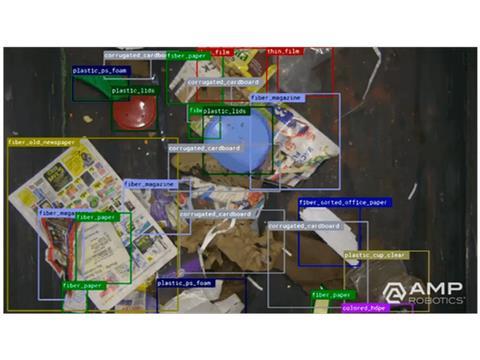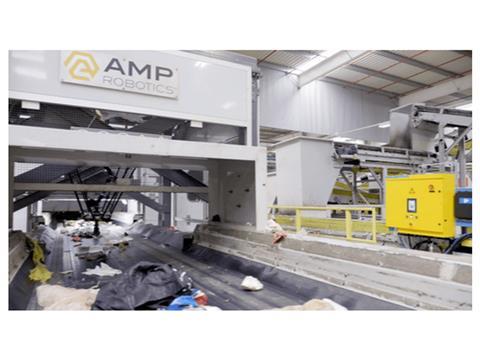
AMP Robotics uses automation and artificial intelligence (AI) to sort materials within waste streams. We asked CEO Matanya Horowitz how this works, how data can be utilised and the ways automated sorting could impact the packaging industry.
AMP Robotics developed an AI platform (AMP Neuron) to distinguish recyclable materials from waste. How did you come up with the idea?
Ever since I was a child I’ve been interested in robotics and the origins of intelligence. While studying for my PhD in Controls and Dynamical Systems at California Institute of Technology, I saw some of the major results in the subject now known as deep learning.
A series of algorithmic breakthroughs led to machines learning how to see for the first time, roughly as well as a human. After graduating, I wanted to find places where this technology could be useful, and I found that in the world of recycling.
It seemed like the recycling industry had the biggest need for this technology. When I visited recycling facilities, I talked to people about the challenges they were facing.
They told me about issues with the quality of the materials being separated out during the recycling process and high rates of staff turnover in the facilities. The convergence of machine learning and robotics offered compelling opportunities to automate what had historically been tasks that were labour intensive, high cost, inconsistent, and limiting. Automation could unlock significantly more value from these complex, heterogeneous material streams.
How does Neuron recognise different products and remove the correct ones from the waste stream?
AMP’s proprietary AI technology, AMP Neuron, works by looking at images of recyclable materials on conveyor belts within recycling facilities. The camera perceives material very similarly to the way a human would.
Looking for specific colours, shapes, textures, logos, and more, the system recognizes patterns correlated with material type. Neuron digitises these images and uses the data generated to infer in real time the recyclable materials and contaminants in sortation environments.
It continuously trains itself by processing millions of material images into data, building upon an ever-expanding neural network that adapts to changes in a facility’s material stream.
What data does Neuron transmit to the robots? How is information passed between them?
Neuron digitises every image of each item it sees on the conveyor belt, then guides the robotic arm to pick the programmed material(s), according to customers’ settings. As more robots are deployed, the industry can leverage the networked intelligence of hundreds of units.
The more AI-based robots and sensors we deploy into production, the more a network effect is created. In the case of our systems, this network effect exponentially increases the sorting intelligence.
If a challenging packaging type or new material emerges, we’re able to capture imagery and train the AI to identify the object. This knowledge is then deployed throughout the fleet of robots.
In essence, the more robots we deploy, the more each customer is helping another customer by expanding the AI’s material knowledge. What’s interesting is that the AI can learn to identify nearly anything a person can be taught to identify.
This means AI can go beyond plastic resins or other material types. It can identify brands, form factors, certain types of damage. This gives a whole new level to sorting capabilities. For instance, it can identify aluminum foil versus aluminum cans, or food grade versus non-food grade polypropylene.

What are the most common issues you come across with sorting for recycling?
Recycling involves infinite variability in the kinds, shapes, and orientations of the objects found on a conveyor belt. Training a neural network to detect objects in the recycling stream is not easy—but it’s an entirely different challenge when you consider the physical deformations that these objects can undergo by the time they reach a recycling facility.
They can be folded, torn, smashed, or partially obscured by other objects. This challenge is mirrored in the robotic grippers, where you need to be able to handle an unbelievable variety of different form factors and types of damage to the packaging.
There’s also the challenge of staying up to date with the continual changes in consumer packaging. Any mechanism that relies on visual observation to learn associations between packaging and material types will need to consume a steady stream of data to ensure that objects are classified accurately.
How do you work with businesses, governments and NGOs to improve recycling rates?
We’re working to improve the economics and efficiency of recycling – driving down the cost of recycling and significantly increasing the volume of high-quality recycled feedstock. We’re doing that by deploying our technology into existing facilities as a retrofit solution, and by operating our own facilities, designed with AI from the ground up.
One important element for governments and NGOs is that AI significantly decreases the cost of measuring what’s happening in a facility. Each AI sensor can identify nearly all the different material types that are of interest.
With its software-focused approach, the cost to do “waste characterisation” within a facility drops from thousands of dollars per ton to only several dollars (or in some applications less than a dollar) per ton. This is a several-orders-of-magnitude reduction in cost of understanding what’s really happening to material flows in the industry.
What role can automation play in improving recycling and sustainability in the packaging industry? What changes or improvements could be implemented?
Automation in recycling drives consistency, as robots can work 24/7. They don’t tire, nor do they need breaks. Plus, they can work on faster-moving belts than humans.
Their consistency also results in higher quality of recovered commodities. Robots are flexible; our systems can be adjusted to reflect material stream changes, commodity prices, and more.
The digitisation of scrap objects in the MRF [Material Recovery Facility] opens up many potential applications. The first two deployed in MRFs today are robotic sorting and the descriptive and diagnostic analytics provided by standalone sensors.
As the sensors become distributed throughout a MRF, we’re able to help the MRF become a more data-driven facility to reduce costs and increase revenue. Currently, the MRF is a centralised material hub, but the proliferation of these sensors begins to transform MRFs into information hubs.
Data capture in MRFs can also influence the design of new facilities. For example, AMP’s application of AI for material identification and advanced automation has matured to the point where it’s become viable to develop high-diversion secondary sortation facilities that are economical to deploy and sustain nationally.
Through our secondary sortation model, AMP recovers mixed paper, metals, and a portfolio of #1-#7 plastics in a variety of form factors and attributes with high precision and purity, with a special focus on plastic blends uniquely enabled by AI. We resell these commodities, including bespoke chemical and polymer blends needed by processors and manufacturers, to end-market buyers.
Our technology can help producer initiatives to increase recycling rates and create new value streams for recyclables, ultimately aiding their pursuit of recycled content goals. As Extended Producer Responsibility (EPR) schemes emerge and mature, sensors growing in the fleet of MRFs can help satisfy the demand for reporting recovery rates.
Data collection, measurement, and material characterisation for recycling also create a mechanism to support federal, state, and local government programs focused on landfill diversion goals and recycled content standards to advance a more circular economy.

AMP is currently developing a solution to improve the recovery of film and flexible packaging. What are the specific challenges there, and how might this solution impact the current infrastructure in the packaging industry?
One of our newest innovations is AMP Vortex, an AI-powered automation solution designed to improve the recovery of film and flexible packaging. The recycled materials industry lacks infrastructure for the identification and separation of film and flexible packaging, and these materials jam MRF equipment not designed to manage it.
Film and flexible packaging find their way into every line in a MRF, resulting in high levels of contamination. But most of these materials, given their light weights, make their way onto fibre lines.
Film contamination degrades fibre bale purity, leading to revenue loss or the need for additional post-handling downstream. Because these materials are complicated and expensive to reclaim into raw materials, end markets for film and flexible packaging have been limited.
We’re developing Vortex to target and recover film and flexible packaging for baling and selling, which will ultimately reduce the waste generated by these materials.
What goals would you like to see AMP achieve in the future?
Our mission is to apply technology to enable a world without waste. We’re already growing in areas like C&D [Construction and Demolition], e-scrap, and organics, but our goal is to apply our technology in any setting where we can boost the margin that can be made per ton of material.
As the industry responds to the commitments made by consumer-packaged goods companies to use more post-consumer recycled content, the demand for AI and robotics to modernise existing recycling facilities continues to thrive.
With these retrofits, we see opportunity in several areas, from the breadth and precision of material characterisation capabilities, to increasing use of data to improve recycling operations, to helping policy makers achieve sustainability targets.












No comments yet